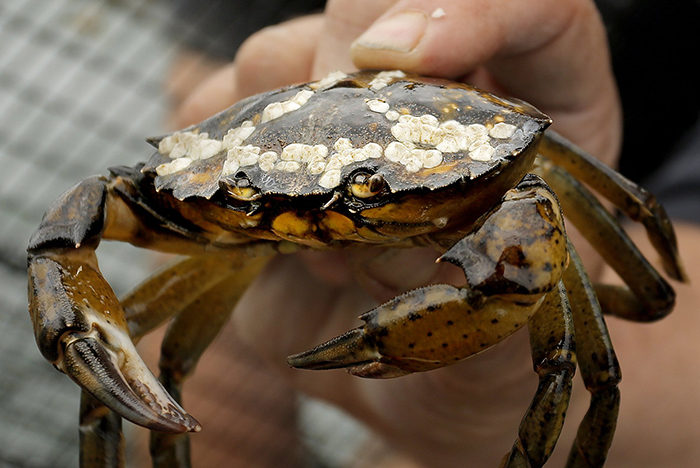Gov. Paul LePage on Friday ordered the creation of a task force to study and combat the invasive European green crab, which fishermen along the coast have said is decimating shellfish populations.
Although the species has been reported in Maine since 1904, recent weather patterns and warming ocean temperatures appear to have allowed the tiny critters to multiply and move north, devouring blue mussels, soft- and hard-shell clams and coastal grasses.
The crabs have contributed to wetland erosion and have depleted populations of spat, the tiny juvenile clams that are easy targets for the voracious species.
“Green crabs are threatening our state’s $25 million bivalve shellfish industry, which is Maine’s third most lucrative fishery,” LePage said. “It’s critical that we protect the fishery and the good jobs the industry supports.”
The 12-member panel will include representatives of the state departments of Marine Resources, Environmental Protection, and Economic and Community Development, towns with shellfish ordinances, the bivalve fishery and marine industry, and three researchers.
The task force will be charged with identifying the direct economic impact of the crabs on the shellfish industry; develop long-term eradication and control plans; and identify the cost of the crab-control strategies. A report is due by Sept. 30.
Brian Beal, a marine ecologist at the University of Maine who specializes in shellfish, struck a balance between optimism for the governor’s recognition of the problem and the challenge that lies ahead for the task force members.
“It’s going to be a lot of work to complete,” said Beal, who was present during the governor’s announcement at the annual Maine Fishermen’s Forum in Rockport.
Beal said the regulatory environment is ripe for changes, and that a group of focused professionals could come up with a creative solution that until now has been prevented by state-imposed limits on green crab fishing.
“How do you get rid of an invasive species? You fish ’em to death,” Beal said. “We did an awful good job of reducing the population of sea urchins without even trying.”
Beal said reducing or eliminating catch and size limits imposed in 2000 would be a logical first step to reducing the green crab population.
Creating a viable economic market for the critters would be next, he said, either as fodder for compost and fertilizer, chicken feed and pet food or as a source for a medically valuable substance contained in the crabs’ shells.
“I think if there’s a price that fishermen will get for their effort that’s economically doable, then I think the sky’s the limit,” he said.
But the challenge ahead is daunting, said Sara Randall, a spokeswoman for the Maine Clammers Association. Randall said about 90 percent of the clam flats in Casco Bay are devoid of legally harvestable shellfish. Only the areas nearest the shoreline have remained impenetrable to the crabs, which come toward shore from deeper waters.
Also unknown, Randall said, is the impact of the crabs on the lobster fishery. Lobstermen are reporting more green crabs in their traps, forcing the fishermen to plumb deeper water farther offshore to find lobsters.
In laboratory settings, green crabs outcompete lobsters, especially when lobsters are still young, she said.
“The devastation is so profound at this point,” Randall said.
Both Beal and LePage reiterated that on top of concerns about the environment and the economic threat to clammers’ jobs, the state’s tourism industry could also take a hit, posing a gustatory dilemma in a state known for its seafood.
“How do you have a clam bake without any clams?” Beal said.
Matt Byrne can be contacted at 791-6303 or at:
Twitter: MattByrnePPH
Send questions/comments to the editors.




Success. Please wait for the page to reload. If the page does not reload within 5 seconds, please refresh the page.
Enter your email and password to access comments.
Hi, to comment on stories you must . This profile is in addition to your subscription and website login.
Already have a commenting profile? .
Invalid username/password.
Please check your email to confirm and complete your registration.
Only subscribers are eligible to post comments. Please subscribe or login first for digital access. Here’s why.
Use the form below to reset your password. When you've submitted your account email, we will send an email with a reset code.